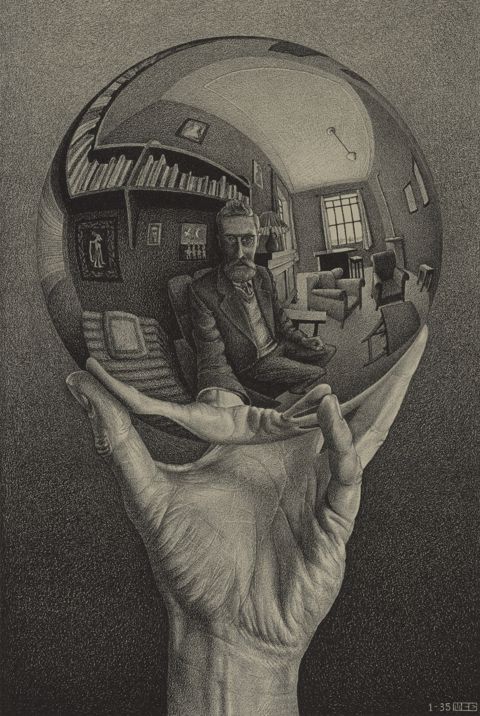MFAH Presents “Virtual Realities: The Art of M.C. Escher from the Michael S. Sachs Collection” in March 2022

M.C. Escher, Hand with Reflecting Sphere, January 1935, lithograph, collection of Michael S. Sachs. © The M.C. Escher Company, The Netherlands. All rights reserved.
M.C. Escher, Drawing Hands, January 1948, lithograph, collection of Michael S. Sachs. © The M.C. Escher Company, The Netherlands. All rights reserved.
M.C. Escher, Relativity, July 1953, lithograph, collection of Michael S. Sachs. © The M.C. Escher Company, The Netherlands. All rights reserved.
M.C. Escher, Bond of Union, April 1956, lithograph, collection of Michael S. Sachs. © The M.C. Escher Company, The Netherlands. All rights reserved.
Houston will debut this major retrospective of over 300 works on paper and more than 100 of the artist’s carved wood blocks, constructed objects, and working tools
HOUSTON—DECEMBER 17, 2021—The Museum of Fine Arts, Houston, is pleased to present the largest and most comprehensive exhibition of works by M.C. Escher ever held, from the collection of Michael S. Sachs, who gathered works over 50 years and acquired 90 percent of the Escher estate in 1980. The exhibition will include more than 400 prints, drawings, watercolors, printed fabrics, constructed objects (such as the Angels and Devils sphere), wood and linoleum blocks, lithographic stones, sketchbooks, and the artist’s working tools. Organized by the MFAH, the exhibition will be on view March 13 to September 5, 2022.
Maurits Cornelis Escher, popularly referred to as M.C. Escher, is known internationally for his self-described “mental images,” which connect to mathematics and various branches of science. Considered a “one-man art movement,” he remained outside of the art establishment. Escher was heralded in the psychedelic era of the 1960s and 1970s and is treasured today for his mind-bending works.
“The Museum of Fine Arts, Houston, is pleased to present this broad selection of works by M.C. Escher, drawn from the most extensive Escher collection in the world,” said Gary Tinterow, Director and Margaret Alkek Williams Chair, Museum of Fine Arts, Houston. “Escher is an artist who defies characterization. His singular, sometimes unsettling works, with their orchestration of multi-dimensional alternate realities, have rightfully become icons of the 20th century.”
Evolution of Escher Imagery
Over his 50-year artistic career, Escher’s imagery evolved from realistic observations of the world around him to inventions from his own imagination that explored the relationships between art and science, order and disorder, and logic and irrationality. Escher once commented: “You have to retain a sense of wonder; that’s what it’s all about.”
Throughout the 1920s and 1930s, Escher was preoccupied with the Italian landscape and the architecture of Italian cities. It was during this period that he began experimenting with perspective in his work. The patterned, color tiles from Moorish architecture he saw in Spain in 1922 and 1936 were transformed in Escher’s hands from geometrical symmetries to identifiable human figures, angels, and other creatures, such as insects, birds, fish, and reptiles. In Sky and Water I (1938), Escher’s use of metamorphosis evolves fish into birds, and vice versa, in a seamlessly interlocking, seemingly infinite, pattern. Space that evolves from two- to three-dimensions is also an important theme for the artist. In Reptiles (1943), a salamander escapes the paper it is drawn upon, then re-enters the sheet on the other side. In Hand with Reflecting Sphere (1935) and Magic Mirror (1946), the effect of the globe and mirror reflections creates two co-existing worlds in time and place. Included in this exhibition will be the never-ending tessellating cycle Metamorphosis III (1939–68), Escher’s largest print, more than 22 feet in length and accompanied by its 31 woodblocks.
“By spanning Escher’s entire career, this extraordinary exhibition explores Escher’s detailed thought process. It reveals, in a way, the magic behind the final prints, with the inclusion of preparatory drawings and progressive printing proofs as evidence of his working process. His meticulous manner extends to printing all of his woodcuts by hand with the back of a spoon, instead of a press,” said Dena M. Woodall, Curator, Prints and Drawings, MFAH.
Escher’s Multiple “Modern” Preoccupations
The exhibition will be organized chronologically as well as thematically, from portraiture and Escher’s student and early work to his imagery from Italy. It will then branch out into Escher’s multiple “modern” preoccupations: tessellations, metamorphoses, two-dimensions into three-dimensions, reflecting worlds, Platonic solids, spirals in space, impossible buildings, and approaches to infinity. Interactive auxiliary rooms, where visitors may play with optical illusions, will accompany the exhibition.
About M.C. Escher
Born in Leeuwarden, Friesland, the Netherlands, M.C. Escher (1898–1972) as a young man intended to be an architect, enrolling in the School of Architecture and Decorative Arts in Haarlem. His interest during his studies from 1919 to 1922 shifted away from architecture and, under his teacher Samuel Jessurun de Mesquita, toward drawing and printmaking, which became his life-long passion. In 1922, Escher traveled throughout Italy, particularly Tuscany and the Amalfi coast, as well as Spain. The Italian countryside and the Moorish architecture and complex decorative designs of the 14th-century Alhambra in Granada were powerful influences. In 1935, signs of impending war forced Escher and his young family to move to Switzerland and subsequently to Belgium. In 1941, during the height of World War II, they returned to his homeland, the Netherlands, settling in Baarn, where he lived and worked for the remainder of his life.
Organization & Funding
Virtual Realities: The Art of M.C. Escher from the Michael S. Sachs Collection is organized by the Museum of Fine Arts, Houston. It is curated by Dena M. Woodall, curator, prints and drawings, MFAH.
Generous support provided by:
Luther King Capital Management
Vivian L. Smith Foundation
Marty and Kathy Goossen
Martha and Richard Finger
Marc Grossberg
The Francis L. Lederer Foundation, courtesy of Sharon Lederer and Ellis Mills IV
Elizabeth and George Passela
Grace Phillips and Eugene Nosal
The Scurlock Foundation
This program is supported as part of the Dutch Culture USA program by the Consulate General of the Netherlands in New York. 
Publication
Catalogue to be published after the exhibition.
About the Museum of Fine Arts, Houston
Established in 1900, the Museum of Fine Arts, Houston, is among the 10 largest art museums in the United States, with an encyclopedic collection of nearly 70,000 works dating from antiquity to the present. The Museum’s Susan and Fayez S. Sarofim main campus comprises the Nancy and Rich Kinder Building, designed by Steven Holl Architects and opened in 2020; the Audrey Jones Beck Building, designed by Rafael Moneo and opened in 2000; the Caroline Wiess Law Building, originally designed by William Ward Watkin, with extensions by Ludwig Mies van der Rohe completed in 1958 and 1974; the Lillie and Hugh Roy Cullen Sculpture Garden, designed by Isamu Noguchi and opened in 1986; the Glassell School of Art, designed by Steven Holl Architects and opened in 2018; and The Brown Foundation, Inc. Plaza, designed by Deborah Nevins & Associates and opened in 2018. Additional spaces include a repertory cinema, two libraries, public archives, and facilities for conservation and storage. Nearby, two house museums—Bayou Bend Collection and Gardens, and Rienzi—present American and European decorative arts. The MFAH is also home to the International Center for the Arts of the Americas (ICAA), a leading research institute for 20th-century Latin American and Latino art. mfah.org
Media Contact
Melanie Fahey, Senior Publicist
mfahey@mfah.org | 713.800.5345
